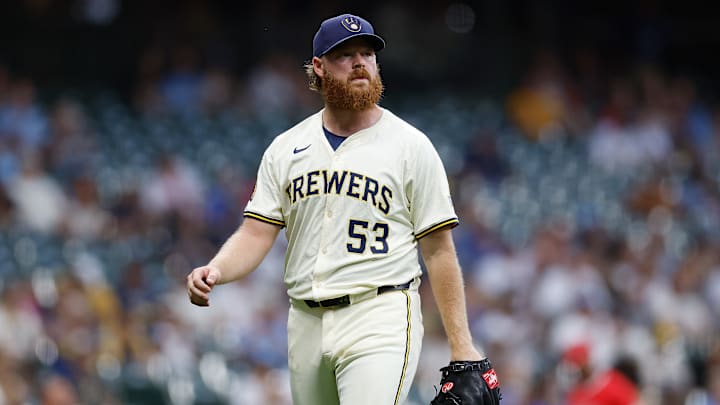The Milwaukee Brewers don’t have to squint to see where this is headed. As soon as the San Diego Padres starting pitcher Michael King became the first player to decline a mutual option this offseason, the shape of Brandon Woodruff’s winter came into focus for Milwaukee. Different uniforms, same math: premium stuff, truncated workloads, recent medical files that make long-term guarantees hard to swallow, and just enough late-season performance to convince a bidding team that the upside is worth the dance.
If the Padres are expected to tack on a qualifying offer and watch King test a volatile market anyway, it’s a pretty clean template for how the Brewers’ front office should think about Woodruff, prepare for optionality, protect the downside, and assume the player will chase a long-term deal even if the average annual value (AAV) isn't as strong.
Padres' Michael King gives Milwaukee Brewers a roadmap for Brandon Woodruff
From the Brewers’ perspective, King’s move is a blinking road sign. Mutual options are formalities for top-end arms with leverage, and King just confirmed it. He declined, he’ll likely see a qualifying offer from San Diego, and he’s still positioned to shop for either a one-year “prove-it” pillow or a shorter multi-year pact that prices in risk with a higher AAV.
Woodruff’s lane looks remarkably similar, especially after he officially declined his side of the mutual option on Monday afternoon. Woody missed all of 2024 and half of 2025 after right-shoulder surgery, yet when he was on the mound, he looked like himself: 7–2, 3.20 ERA, 83 strikeouts across 64 2/3 innings. If Milwaukee believes the market will treat Woodruff like King, injury-discounted, but still premium when healthy, the club’s best move is to set a firm value and be ready with a qualifying offer plus a menu of creative structures, now that Woody is officially a free agent.
The comparison isn’t hand-wavy; it’s point-by-point. King threw only 15 starts in 2025 due to a nerve impingement and a knee issue, yet finished 5–3 with a 3.44 ERA over 73 1/3 innings and even logged a complete-game shutout. Woodruff’s workload was similarly capped, but his per-inning dominance held. Both righties are classic high-upside/high-variance bets: front-line impact when upright, weeks on the IL when not. That profile rarely yields seven-year megadeals. For the Brewers, that’s workable, if the price protects 2026 payroll flexibility and the medicals align.
Here’s where King’s example helps Milwaukee set the lanes. If a qualifying offer appears for King and he still walks, it tells you what the top tier of the market is signaling: elite clubs will pay for ceiling even if the floor is wobbly. Translate that to Woodruff. If the Brewers extend a QO and Woodruff declines, Milwaukee secures a compensation path and keeps negotiating leverage, either on a one-year reunion with incentives or on a shorter multi-year with opt-outs that lets the pitcher rebuild long-term value. If he accepts, the Brewers get a high-octane rotation anchor on a one-year bet without surrendering future flexibility. Either outcome is defensible; the mistake would be letting the market set terms while Milwaukee waits.
The baseball case for betting on Woodruff remains strong. Milwaukee also knows his usage puzzle better than anyone: how to schedule extra rest, when to pull early, and how to stagger him around bullpen strength. That institutional knowledge has real dollar value.
King’s decision, then, isn’t just Padres news, it’s strategic intel. It tells the Brewers to prepare for movement, to assume the player will explore term, and to meet that reality with structure rather than sentiment. Offer the qualifying deal. Have a one-year incentive-heavy framework ready. Price a two- or three-year pact with an early player option and medical triggers. And be comfortable walking if the market leaps to “healthy-ace” money without “injury-risk” guardrails. That’s how you respect Woodruff’s ceiling without gambling the balance sheet.
